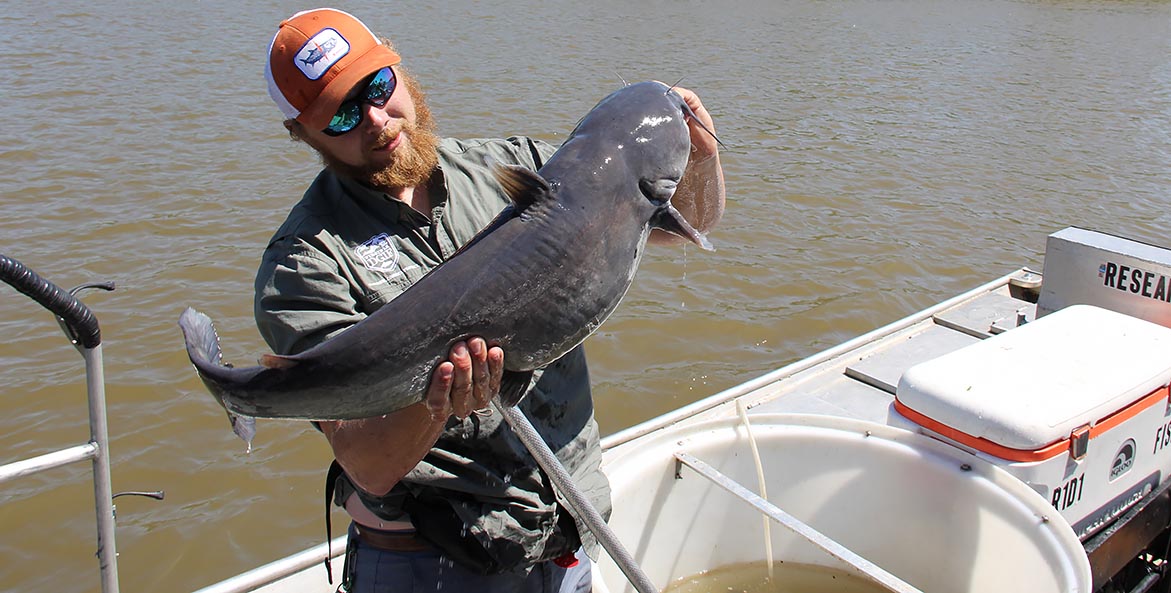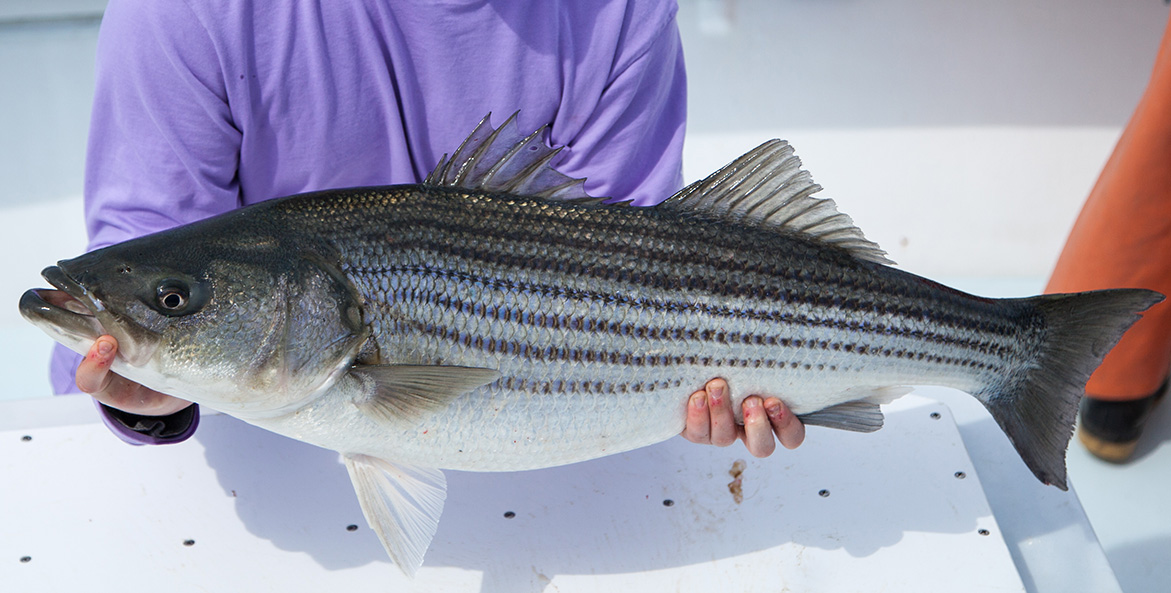Signs increasingly indicate that something is not quite right for striped bass, one of the most revered fish in the Chesapeake Bay and along the Atlantic Coast. In this in-depth series, we examine how a potent mix of fishing pressure, invasive predators, changing climate and habitat conditions, and disease is impacting the population—and what can be done to help.
As migrating striped bass prepare for their annual journey south from New England to their overwintering waters off the Mid-Atlantic, fishery managers are also considering big moves. In October, two major barometers of the population’s health were released. Neither painted a rosy picture.
What the Latest Science Says About Striped Bass
In the Chesapeake Bay, the annual survey of young striped bass showed extremely poor production for the sixth consecutive year in Maryland and the second consecutive year in Virginia waters. The Maryland survey index showed 2.0 fish per sample, compared to a long-term average of 11.0, while the Virginia index reported 3.43 fish per sample compared to a long-term average of 7.77. The results are alarming because the Bay remains the most important nursery area for striped bass on the Atlantic Coast, producing upward of 70 percent of the coastal population.
In addition, an updated assessment of the coastwide striped bass fishery concluded that there is a less than 5 percent chance to rebuild the population by the 2029 deadline that managers aim to meet. The assessment found that the population remains overfished—meaning the abundance of striped bass, and in particular the abundance of mature female fish capable of reproducing, is below what managers deem sustainable.
“This shows that six years of poor reproduction are catching up with us and despite managers’ recent efforts, we are not on track to rebuild the striped bass population,” says Allison Colden, CBF’s Maryland Executive Director and a fisheries expert.
Striped Bass Management Actions on the Table
In late October, members of the Atlantic States Marine Fisheries Commission (ASMFC), the multi-state body that manages striped bass and other fisheries along the East Coast, convened in Annapolis, Maryland, to consider next steps.
Despite a clear sense of urgency from ASMFC commissioners, they ultimately decided they needed additional information on options they could implement in the striped bass recreational and commercial fisheries to achieve additional reductions in striped bass mortality. The results of those analyses will be presented to the Commission at a special meeting scheduled for December.
It’s true that the number of striped bass now is not as low as it was during the population crash of the early ’80s...But it is also true that conditions today are not the same as they were then.
Options likely to be considered then include changes to recreational and/or commercial slot limits. Slot limits set the minimum and maximum size of fish that can be caught and kept by anglers. In 2023, some of the most restrictive slot limits to date were set for striped bass in an attempt to reduce harvest of large adult fish spawned in 2015.
Now, fish from the 2018 year class, the last year of above-average reproduction, are reaching a size that could be subject to increased harvest unless the size of fish allowed to be harvested is adjusted.
They may also consider seasonal closures. Striped bass migrate along the Atlantic Coast throughout the year, making them vulnerable to fisheries in different states as they move. Seasonal closures that correspond to when striped bass are most available and/or times of the year with the greatest fishing effort could help reduce striped bass removals. Seasonal closures could also consider times of the year when fish are stressed from environmental conditions, like summer months in the Chesapeake Bay.
While not without costs, regulations like this could help stave off more drastic measures like a total fishing ban. They are also some of the only steps left, given that managers have already tightened size and catch limits for striped bass over the past two years.
“These are really the only other levers besides a moratorium that managers have to pull,” says Chris Moore, CBF’s Virginia Executive Director and a fisheries expert.
The Future of Striped Bass in a Changing Ecosystem
Still, immediate management actions are just one piece of the striped bass story. While fishing regulations are absolutely necessary in the short term, creating a sustainable population in the long term requires changing the way we think about fisheries, say Colden and Moore. That means recognizing the complex interactions between fish species—including invasive predators like blue catfish—as well as rapidly shifting environmental conditions caused by climate change and development in the watershed, especially along the shoreline.
When the striped bass population last crashed in the late 1970s and early ’80s, management measures, including a fishing moratorium in Maryland, helped the population rebound.
“But we also had really good spawning conditions that helped turn things around,” Moore says. “I’m not sure we are going to have that same response this time.”
It’s true that the number of striped bass now is not as low as it was during the population crash of the early ’80s (there were an estimated 110 million total striped bass in 1985, the year Maryland implemented its fishing moratorium, compared to an estimated 177 million fish in 2023). But it is also true that conditions today are not the same as they were then.

Invasive blue catfish now dominate the reaches of key striped bass spawning rivers, and there is evidence they prey on large numbers of the striper young.
Kenny Fletcher/CBF Staff
For example, invasive blue catfish now dominate the reaches of key spawning rivers, and there is evidence they prey on large numbers of young striped bass. Rising water temperatures and low oxygen levels—both exacerbated by climate change—are pummeling striped bass in the Bay during summer, which is also a popular fishing time. The consecutive years of extremely poor young-of-year surveys appear to indicate that all of this is making it harder for striped bass to successfully reproduce and have those fish survive to adulthood.
“We have a biomass of adult spawning fish that, while it’s much lower than we’d like it to be, should theoretically have the potential to produce many more young than are being observed,” says Colden. “Things like removing fishing pressure on adult females will help—and certainly won’t hurt—but we can’t necessarily expect the population to bounce back like we saw in the late ’90s and early 2000s because there are also other environmental factors at play.”
Alleviating fishing pressure is still the most immediate solution, but it’s a tough sell. The recreational striped bass fishery remains one of the most popular on the East Coast and in the Chesapeake Bay. A spike in the recreational harvest in 2022, when the last really good year-class of striped bass became large enough for anglers on the coast to legally keep, prompted emergency management actions to limit the size and number of fish caught. Managers worry a similar spike could happen next year, when another strong year-class of fish reaches harvestable size.
Ultimately, managers are operating in a new ecological reality that they must take into account if they want to ensure the long-term wellbeing of both striped bass and the fishery, says Colden.
“The ecosystem is changing around us,” she says. “We have to respond to that ecological context as fishery managers to make sure the ecosystem can continue providing at a level that’s not just sufficient for us, but for the species.”




